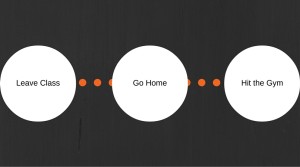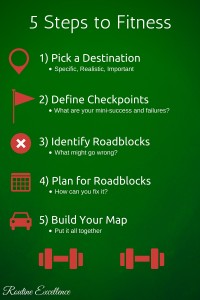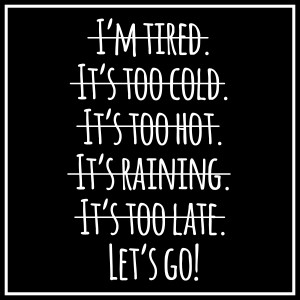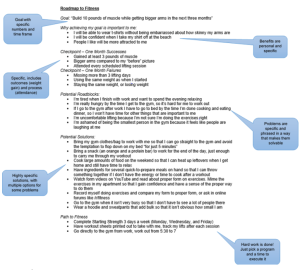
When new exercisers are struggling to develop a consistent gym routine, I often see them given a simple piece of advice, one that will be familiar to any Nike enthusiasts out there – Just Do It.
To an experienced lifter or otherwise fit person, “just do it” seems like a reasonable way to approach fitness. They already know how to work out consistency, have a specific program to follow, and are confidence that they are doing things correctly.
But for a beginner that’s tired after work, or feels like there’s always another project that needs attention, “just do it” is exhausting advice. It adds to the list of things that “should” be done without actually providing guidance on how to get them done. Just do it? How?
Step 1: Want a toned body
Step 2: Just do it
Step 3: ???
Step 4: Abs like Bruce Lee
To consistently go to the gym, you need to break down the “how” of just doing it. Willing yourself to success doesn’t work: you need a complete workout plan for the gym – one that keeps you on track even when life gets in the way. That’s what I want to help you with.

I wrote this guide because I used to feel like a failure. The first time I went to the gym I was terrified. Every time I skipped the gym or quit another exercise routine, I hated myself because it felt like I could never achieve my fitness goals.
It doesn’t have to be that way; you can overcome gym anxiety. I want to help you do better – and show you how to be consistent with exercise.
Beyond gym tactics or specific workouts and diets, workout consistency is easily the most important element of an exercise program.
Part 1 of this guide will teach you some of the tactics you can use to reduce your reliance on willpower. Part 2 will put those tactics together in a simple 5 step exercise.
At the end of these 5 steps – which should only take you about 30 minutes to complete – you will have a clearly defined plan that gives you the motivation to go to the gym, helps you set fitness goals, and shows you how to create a habit of working out that achieves those goals.
Don’t have time to do this right now? I put together a guide and worksheet based on this article (that includes a couple of bonus exercises). Just let me know where to send it.
Send me the guide
(You’ll also get the free eBook 51 Motivation Tips, for when you need an extra boost)
Table of Contents
- Part 1: 4 Psychological Tactics to Stick with an Exercise Routine
- Part 2: Building Your Roadmap to Fitness
- Wrapping Up: A Guide to Workout Consistency
Part 1: 4 Psychological Tactics to Stick with an Exercise Routine
Willpower is a pretty ineffective way of sticking to new exercise routine. Think about trying to force yourself to get out of bed, force yourself to pack your gym bag, force yourself to get out of your apartment, force yourself to go to the gym, and force yourself to actually work out.
It sounds exhausting. But it doesn’t have to be.

The problem with using willpower is that there are so many opportunities to turn back. At any point in the above process, you could decide that your bed is more comfortable, that the gym is far away, or that you’re tired and will just hop on the treadmill for a few minutes. Put another way, you need to “say yes” to the gym a dozen times every time you work out!
I like to think of it this way: if you need willpower to say yes, your default setting is no.
I would rather “say yes” once. Or, even better, have to force myself if I want to say no. The 4 tactics I’m about to describe are based on the psychology of habit formation, and are designed to make it easier for you to “say yes” and find the motivation to go to the gym.
It wouldn’t be fair to say that willpower is wholly unnecessary to creating a habit of working out, but your goal should be to minimize the use of willpower whenever possible.
As you build up your workout routine, there will be moments where you need to use willpower to keep yourself on track. We want to build a strong exercise habit to make sure that you have willpower reserves when you really need them.
Workout Consistency Tactic 1: Chaining
Most habits are cued by something. That is, something external triggers your body to complete a well-practiced routine.
Take brushing your teeth, a deeply ingrained habit that you probably execute regularly and think about executing almost never. For tooth-brushing, the cue is a time (morning) and a place (the bathroom).
One way to develop workout consistency is to connect it to an event that you know will always happen at the same time or place. In college, for example, I liked to work out directly after afternoon classes. I would leave class at 4:05, get to my dorm room at 4:15, change my clothes, and be in the gym by 4:35.
Breaking down the chain of actions, it’s clear that cuing served a vital role in getting me to start working out and stick to it. The first action, leaving class, was guaranteed to happen. The second, returning to my dorm room, was an unrelated but strong habit that I had already established. Finally, I changed clothes and hit the gym.

The progression of these actions is important, because it can help us understand how to chain exercise onto events that already happen. All I did was tack exercise onto the end of an existing habit chain.
For me, the chain was a hugely effective tactic that started off my workout consistency habit. In fact, I found it much harder to work out on weekends, or days with cancelled class. The reason: there was no chain, and therefore nothing to cue going to the gym.
Keep the Chain Going
A crucial aspect of chaining is continuity. When I walked into my dorm room, I didn’t dump my stuff and flop down on my bed “for just 5 minutes,” because doing so would kill my momentum and make it way harder to get moving again.
Actually, I did face that problem at first, before I realized what was happening and cut it out. The moment of choosing not to flop down on my bed and watch Netflix or Reddit is one that legitimately uses willpower (although the coming tactics will provide ways to further reduce it), and if I had been particularly savvy I would have avoided my dorm altogether, preventing the temptation to laze around.
Nowadays I avoid going home after work, bringing my workout stuff with me to work so that I have no excuses. That brings me to the next tactic.
Workout Consistency Tactic 2: Precommitment
When do you decide to go to the gym? For a lot of people the decision is made in the moments immediately before going; that is, the decision to go is followed immediately by the act of going. This is a huge mistake.
Imagine that you’ve just walked in the door from work, and are thinking about going to the gym. You could go, pack your gym bag, change, drive to the gym, and work out. Or you could lie on your bed and browse the internet. You could catch up with that show on Netflix. You could read the book that you’re in the middle of.
Making a decision in the moment requires a lot of willpower because there are a thousand things that distract you. If you are going to lift in the morning, you have to force yourself to get out of bed early, do your whole morning routine, and get your gym stuff together before you can exercise. It’s a lot easier to hit snooze.
When you make decisions in the moment you are at the whim of your mental state in that moment. Tiredness or stress are common states that make it much, much harder to say yes to exercise. How can you overcome them?
By using precommitments.
If your decisions in the moment are impacted by the things happening around you, all you need to do is separate the decision from the action. When you’re tired after work, it will be easier to tune out the many tasks clamoring for attention because you’ve already planned to work out.
A note: a verbal precommitment is not enough. You need to actually change your environment and take meaningful actions that remind you of the commitment you’ve made. That prove you have a real workout schedule. Let’s look at some examples.
Examples of Precommitments
One of the simplest examples of a precommitment is having a partner. Finding an exercise partner is tired advice by now – everyone says to do it – but it is also a good example of precommitment. Agreeing to meet your partner at a particular time and place makes it difficult to renege on going to the gym.
If you can get a partner, it’s the closest thing to a silver bullet for workout consistency.
Another simple example is preparing your gym bag in advance. I have a small, black drawstring back that has my lacrosse balls/softballs (for rolling myself out), a mini-band for my glute exercises, a band to stretch with, and my gym shoes. This bag is rarely unpacked, and I bring it and a change of clothes to work every day. When I leave work, I already have everything I need.

I even knew a guy that used to wear his gym clothes under his work clothes, and occasionally slept in when his workout schedule had morning workouts.
In my chaining example in the previous tactic, I could have reduced reliance on willpower even more by laying my gym clothes out on my bed before leaving for class. That would have made impossible for me to flop down on my bed without literally tossing aside my precommitment.
If you work out in the morning, putting your packed gym bag and ready-to-wear clothes right by your bed accomplishes something similar. You literally won’t be able to get up without stepping on them, and workout consistency will become a lot easier.
There are a lot of ways to use precommitments to your advantage. If you’re looking for ways to start working out and stick to it, this is a big one – the only limit is your creativity in applying the principle to your own life.
Workout Consistency Tactic 3: Reward Yourself
Everyone says to reward yourself for fitness, but few people use effective rewards. Few reward themselves in ways that actually contribute to lasting change. A reward can’t just be a random positive occurrence, and there are specific criteria that make some fitness rewards better than others.
To be effective as positive reinforcement, fitness rewards must be:
- Associated with the stimulus (gym-going)
- Occur shortly after the stimulus
- Occur consistently or semi consistently
With some scrutiny, we can see that common advice on rewards doesn’t really do those things.
What are some of the common “tips” people are given when it comes to fitness rewards?
- Put aside a dollar every time you go to the gym, buy something nice once you hit $50
- Go out for a nice meal
- Have a dessert with dinner
- Take a nap, because you worked hard and deserve it
- Buy yourself a game, or some other fun gadget you’ve had your eye on
There are dozens of other examples plaguing the food and fitness blogs out there, but all of these examples suck. Why?
The rewards are too big
A single, big reward isn’t effective in getting you to maintain a regular habit. Going out to eat every time you go to the gym is pretty expensive, and could be difficult for a lot of people to maintain financially. Same goes for buying yourself a fun new toy.
The rewards are disconnected from gym going
You can have dessert or go out for a meal whenever you want, really. The actions aren’t in any way connected to going to the gym. When people rely on these rewards, they find themselves cheating, taking out rewards in advance of actual achievements.
The rewards happen too long after the gym
Naps are great, but you aren’t going to be taking that nap until you get home from the gym. Putting a dollar in a jar is consistent and small, but you don’t actually get the reward from the action until long after you’ve gone to the gym
My experience using rewards
One example, again from my college days, illustrates what it means to apply the three principles of effective rewards as you build up consistency in the gym.
During the winter months during college, I found it much easier to go to the gym at night, even though that meant giving up the chain I had established during the rest of the year. Why?
The act of gym going was directly related to a consistent, immediate reward: hanging out with my friends.
I would go to the gym at 8:30 to lift. When it closed at 10:00, I would go down to the fieldhouse (in the same building) and hang out at the women’s ultimate practice, an opportunity to throw around with other men’s team players and hang out with my friends on the women’s team.
Lifting was a way for me to hang out with my friends. I needed to go the athletic building to do that, so social time was one of my fitness rewards for a lift. I could not get the reward without going to the gym.
The last point is key. Rewarding yourself with food can work, but only if the food is somehow associated with the exercise routine – maybe you have a favorite coffee shop near your gym. Or else, there could be a used bookstore nearby that you check out. In each of these examples, you need to actually go to the gym to be able to reward yourself, since the reward is in the same place.
One super bare bones example of a reward is to keep a small (nonperishable) supply of candy in your gym bag. After your workout, while you are still at the gym, have one. A small candy will not significantly affect your diet, but it does create an association between the gym and the candy. The immediate and consistent nature of this reward is what makes it different from just having a dessert.
A note on workout punishment
I greatly prefer positive reinforcement to punishment for changing a habit. If you’re serious about developing an exercise habit, it should be something that you enjoy.
Workout punishment introduces negative emotions surrounding exercise, not a good stepping stone to success. In general, it’s easier to do stuff that doesn’t suck. Punishing yourself for not working out is a great way to ruin your workout consistency in the long term.
For that reason, I’m not a fan of programs that cost you money or other punishments for missing workouts. But it’s also important to recognize (and therefore be better able to overcome) the punishment inherent to going to the gym.
One of nature’s cruel tricks is that the first stages of an exercise routine are the most punishing. Before your body has adapted to exercise, it punishes you with extreme soreness. It’s a small wonder that so many people start and stop exercise habits so many times; every time they start, they almost immediately feel terrible!
Understanding that this process occurs is a great first step to overcoming it, but this is also why it’s incredibly important to start slow and build.
Leaping in and going hard on exercise is going to make you feel terrible, and that’s not a feeling you want to have when willpower is still a major part of the equation. A slow start will minimize early soreness; eventually you can ramp up without experiencing any punishing pain.
Workout Consistency Tactic 4: Reducing Barriers to Training
This section is something of a catch-all, incorporating parts of the other three workout consistency tactics and addressing the struggles that they can’t.
You want to make it as easy as possible to say yes to an exercise plan, and that’s what the other three tactics have been dealing with. Preparing your clothes in advance or connecting exercise to other activities are both ways of reducing barriers, just as rewards are ways of adding incentives.
Put another way, you want to both increase the chance of saying yes (rewards) and decrease the change of saying no (reducing barriers).
What are some reasons that people say no to fitness?
Some of these reasons can seem small, but are actually profoundly frustrating. For example, a common problem is coming home after work and the gym, and being too tired to cook dinner. Conventional advice is to “suck it up” or “just do it.” I’ve already aired out my beef with that idea.
A better solution is to prepare meals in advance. I like to cook up a load of chicken or chili on Sundays, giving me enough food in reserve to whip out if I’m too tired to cook during the week.
Failing that, I always keep ingredients for a simple meal on hand. I keep instant oatmeal and quesadilla material around all the time, just in case I need to make something fast without spending a lot of energy. Anticipating my future actions helps me eat better without wasting willpower.
What about other challenges?
What if you feel self conscious in the gym? Going during off-peak hours, using positive self-talk, finding a secluded section to do your workout, or wearing concealing clothes are all ways to reduce the negative effects of gym anxiety.
What if you don’t know what you should be doing in the gym? As a beginner, the most important thing to do is pick an exercise program and stick with it. Having a specific workout program to follow keeps you on track and means that you’ll never have uncertainty.
What if you aren’t sure how to do the exercises, because they seem complicated or make you nervous? Watch form videos before you go to the gym. Being armed with that information will help you do everything correctly and reduce any gym-related anxiety.
Nearly every gym-going challenge can be aided by reducing barriers. Thinking critically about what your barriers are is the first step. Then, brainstorm ways to make those problems as small as possible.
Part 2: Building Your Roadmap to Fitness
I call this a “roadmap to fitness” because it provides a guide that tells you exactly how to be consistent with exercise at every stage of your fitness journey.
There are things that this roadmap doesn’t tell you. It doesn’t tell you how to pick the best gym routine, or what new exercises you should be doing. Those are important topics, but are outside the scope of this guide – here you learn how to find the motivation to go to the gym in the first place.
You should finish these 5 steps with a plan that is literally written down (or typed). It doesn’t need to pretty or have a fancy font/format, but it does need to exist outside of your brain in some capacity.
At the end of the 5 steps I’ll give you an actual roadmap so that you have an example of how everything fits together.

Step 1: Pick a Destination
Goal setting activities are constantly recommended by productivity moguls because they let you to measure success and fix failures. Even just the act of setting a goal makes you more likely to succeed.
The thing is, you probably are not trying to be the best at exercise. At least, not “exercise” as a general concept. Workout consistency is the best way to achieve goals, but you still need a goal to work towards.
To maximize your results, it’s worth taking a few minutes to make the right kind of goal. Here are 3 characteristics of goals that set you up for success.
Goal Specificity
Goals need to be specific. Creating a specific goal allows you to clearly define the activities that will make the goal happen. Lack of specificity leads to vague goals like “build muscle.”
A goal like build muscle is too vague because it offers no details about time frame, amount of muscle, location of muscle to be built, or process of gaining muscle. It’s similar to “just do it.”
Goals like “build muscle” are what lead people to activities like “lifting weights.” “Lifting weights” is also too vague: you won’t get muscle by doing the same isolation exercises at the same weight every day.
A goal like “build 10 pounds of muscle while getting bigger arms in the next three months” is much better. With a specific goal it’s easier to see if you are making progress.
You can set short term workout goals, then check in after a month and see if you’ve gained any muscle, or take before and after pictures to see if you’re adding arm bulk the way you want to. If you aren’t seeing progress, you can change your approach. More on this in Step 2.
Common, vague fitness goals include:
- Get toned
- Get ripped
- Have a six-pack
- Get stronger
- Stop being weak
Make your goals more specific to improve your workout consistency.
Realism in Goal Setting
It almost goes without saying that setting realistic fitness goals is important. Every piece of goal setting advice in existence talks about not getting your hopes too high and making sure your goals are realistic.
As it happens, I think setting realistic fitness goals is vastly overrated.
If you’re starting a fitness journey, or any activity, for the first time, you probably don’t have a great sense of how realistic a goal is. It took me 4 years to build 40 pounds of muscle, but if you’d asked me when I started I would have:
- Wanted to get there in a year or
- Thought it impossible to get there at all
Of course you should be realistic in your goal setting. But don’t worry about it too much. A system of regular check-ins and feedback allows you to re-evaluate and adjust your goals if you aim too high.
Importance to You Personally
It sounds like a no-brainer: you are more likely to achieve your goal if you think that it’s important.
Well, yeah. Duh. The problem is that people think of things that are generically important. Everyone already knows that exercise is healthy, but for most people that information hasn’t helped them stick to a program.
Instead of thinking about the abstract importance of exercise, think about what success could mean for you. Again, everyone knows that exercise can make you healthier and better looking, but how would that meaningfully affect your life?

Be as specific as possible. For example:
- I will be able to wear t-shirts without being embarrassed about how skinny my arms are
- I will be confident when I take my shirt off at the beach
- People I like will be more attracted to me
- I won’t have to use the lightest bowling ball when I go bowling with my friends
- I’ll be able to run around and pick up my kid
To appreciate how important your goal is, you need to apply it to your own life.
Action Steps
As you wrap up this step, you should have a clearly defined goal to work with. In addition, write down 3 specific ways that achieving your goal will benefit your life.
Step 2: Define Checkpoints
Defining checkpoints is a method of keeping addressing the problems keeping you from success. If your goal is to be completed in 3 months, you need to check in earlier to make sure that your methods are working.
Checkpoint: a designated point to take stock of your successes and failures before the end of your time frame.

For example, the fitness goal “build 10 pounds of muscle while getting bigger arms in the next three months” could have a checkpoint at one month.
At a third of the way through the time frame, have you gained any weight? If not, it might be time to change your exercise routine or diet. Have you been consistent with exercise? If not, what aspects of your life can you change to make going to the gym easier?
Define success and failure in advance. Write exactly where you want to be by your checkpoint. When it comes time to check in, you will know exactly where you stand and what you need to change to succeed.
For the muscle building example, successes at the end of one month could be:
- Gained at least 3 pounds of muscle
- Bigger arms compared to a “before” picture
- Attended every scheduled lifting session
Failures could be:
- Missing more than 3 lifting days
- Using the same weight as when you started
- Staying the same weight, or losing weight
It’s important to remember that failure is ok – right now. It’s ok because you have a plan in place to deal with it. If you know that you’re on the way to failing at the end of a month, you just have to re-evaluate your strategies! There’s no need to panic; you can still achieve your goal, or revise it if you aimed too high.
Action Steps
At the end of Step 2, you have a list of specific failures and successes that you’ll check-in on at a specific time. You should also be secure in the knowledge that failure is okay at your checkpoints. Feedback and correction at this stage are what prevent one failure from turning into several – these mini-failures represent opportunities to self-correct and get back on track.
Step 3: Identify Roadblocks to Workout Consistency
It’s easy to be motivated before you set foot in the gym. But when you’re tired and hungry, or life gets in the way, exercise motivation disappears and you’ll realize that all you want to do is flop down on your bed and watch Netflix.
The lesson in Step 3 is to plan for when things go wrong. Then, even if you slip off the rails for a moment, you’ll know exactly what you need to do to get back on track.
Now, list out all of the reasons you might fail to create a habit of working out or miss a workout session. In the Step 4 we’ll deal with those challenges.
Again, be specific. Common roadblocks that won’t work:
- “I’m lazy”
- “I’m unmotivated”
- “I don’t have time”
These aren’t specific enough problems to address, and their phrasing prepares you for failure. “I’m unmotivated” suggests that your lack of motivation is an integral part of your character. If that were true, creating a workout habit would mean changing who you are as a person!
It’s not true, and I would discourage you from describing perceived flaws as a part of your identity. Building a workout habit can be challenging, but it isn’t as challenging as redefining yourself.
Better versions of the above roadblocks:
- “I’m tired when I finish with work and want to spend the evening relaxing”
- “I’m hungry by the time I get to the gym, so it’s hard for me to work out”
- “If I go to the gym after work I have to go to bed by the time I’m done cooking and eating dinner. I won’t have time for other things that are important to me”
Do you see how these describe the same problems in fundamentally different ways? You’re not “lazy,” you just want to relax in the evenings. It’s not that you don’t have time, it’s that there are other areas of your life that are important to you.
When phrased like this, your roadblocks are challenges that you can overcome.
Action Steps
The goal of Step 3 is to recognize the workout consistency challenges that you will encounter on the path to achieving your goal. Set a timer for 5 minutes and list all the challenges you can think of as specifically as possible.
Step 4: Plan for Roadblocks
This step is as simple as it can be difficult to execute. You have a list of problems: now all you have to do is solve them.
Brainstorm ways that you can get around the roadblocks that you’ve just listed. If you’ve defined your challenges clearly enough, you should be able to come up with some solid solutions.
Here’s the activity: take 10 minutes and your list of problems. Write down as many solutions as you can think of. Everything goes – you can cull bad ideas after the 10 minutes are up. Focus on capturing as many potential solutions as possible, even if they seem silly.
Here are some examples to get you thinking:
- If you get tired when you get home from work, figure out if you can work out in the morning, get more sleep, or have coffee before you get to the gym
- If hunger prevents you from working out, bring a snack to work for the end of the day, just enough to carry you through to dinner
- If you struggle to train in the morning, pack your workout bag in the evening and put your workout clothes by your bed so that you have to walk over them to get up (I even know a guy that slept in his gym clothes)
These specific examples may or may not apply to you – what’s important is that they address the specific problems identified. Plan ahead now. Then, when you do face challenges, you’ll be ready to overcome them.

Action Steps
Brainstorm potential solutions to the roadblocks you identified in Step 3. Take 10 minutes and list as many solutions as possible, then trim your list down to the best ideas.
Step 5: Build the Roadmap to Fitness
You have all the individual pieces. Now it’s time to put everything together into a single plan, your roadmap to fitness.
Step 5 is deciding the details of what you’ll do for your workout and adding the lists from Steps 1–4.
The format of your road map is not important. If you feel like having multiple colors or incorporating post-its, yarn, and silly putty, by all means do so. The important part is that your map exists in one, accessible piece that you can easily reference.
Here is an example of an actual road map that incorporates all 5 steps.

Wrapping Up: A Guide to Workout Consistency
You have a set of tactics that can help you go to the gym, and a detailed, 5 step system that organizes them into a concrete plan. If you haven’t been completing the steps as you read, I encourage you to do so right now. Just 30 minutes spent planning could give you a gym habit that lasts for years – and the body to go with it.
If you want the info in this article, plus the free eBook 51 Fitness Motivation Tips just let me know where to send it.
Send me the 5-step guide
Bookmarked! Although I barely every skip training sessions, this should keep me on track at my weaker moments. Thanks a lot!
Great practical advice that could easily be adapted to developing positive habits in any aspect of your life — not just working out.
Dude this is way too long to motivate anyone. Duh
I think this is more about discipline than motivation. Motivation gets you started, discipline keeps you going.
No booze - thats my hardest stepping stone. Unbelievable amount of empty carbs
I loved this, thanks for writing it up! As someone who’s trying to make a living helping other people get in shape, this is an awesome resource. =D
Glad you enjoyed it! I hope your clients find it useful as well!
Hi Robert, you have avoided to explain how to change a belief by stating The easiest one of the three to overcome is if you don’t believe you can because all you have to do is change your belief which takes about one second and can be done without getting up from your chair. Can you kindly suggest an easy and effective way to change beliefs? Beliefs are deep rooted in sub-conscious mind and therefore the toughest to replace. And you it takes one second. Kindly elaborate and explain
Hi Landon,
You’re definitely right that beliefs are crucial to success, and they influence every aspect of your life. There’s a pretty famous quote on the subject:
““Your beliefs become your thoughts,
Your thoughts become your words,
Your words become your actions,
Your actions become your habits,
Your habits become your values,
Your values become your destiny.””
I will definitely be writing more about how to change your beliefs, because you’re right that it’s difficult to change your unconscious. My approach towards changing beliefs is this: take the unconscious and make it conscious.
If you want to change your patterns of thinking, you need to practice. How you do this depends on what your beliefs are. If, say, you have the belief that “I’m lazy and suck because I can never go to the gym,” you can practice using the info in this guide. The exercise above reframes your thinking to “I have a lot I care about that gets in the way of the gym, but I’ll work to find a solution.
Similarly, if you think “I could never get really fit,” work on praising yourself when you do gym-related things well. For example, when you come back from the gym, look in the mirror and verbally congratulate yourself on the effort and dedication it took you to make it there. Eventually you can shift your mindset, enjoy gym-going, and worry less. It also gets easier to do this as you start seeing results.
That’s a little bit surface level, but I’ll definitely be writing more on the subject in the future.
Hope this helps!
Excellent article Benyamin! I loved how you tackled the biggest issues people face, and then gave some very practical advice for how to get started and how to stick with it.
One thing that came up in my head while reading this, is that the program and diet need to be well-suited to the individuals goals and their own starting point as well. Some people pick a program much too advanced for them and just get burnt out. I know I couldn’t keep up with Dwayne Johnson’s diet—even with an in-house chef and it was my full time job to eat!
So not only do our goals need to be realistic, but the workout programs and diets we’re trying to follow need to be realistic too 🙂
Anyways, great resource! I’m sure a lot of people will get some useful tricks to help them succeed!
Thanks! I think you’re totally right that the specific programs and diets need to be related to training goals and the individual. A lot of people pick programs for more advanced people and get burnt out, or else don’t see results because their body just isn’t ready to make full use of that program.
A beginner just isn’t going to get the same benefit out of heavy, low reps (1-3) as an intermediate or advanced lifter. That said, I personally am definitely in favor of the 4-6 rep range for beginners.
This post intentionally doesn’t go into program selection because of how huge of a can of worms that is, but I’ll definitely be writing about how to pick a beginner program in the future.
I see you don’t monetize your blog, i think there is one opportunity
to earn additional cash on your blog, search in google for- idol4jp makes money
Hi Vernita,
You’re right, I don’t monetize my blog. Maybe somewhere down the line I’ll look into it, but right now I’m just trying to put out great content and help people live an active, fit lifestyle.
Benyamin
Wow that was odd. I just wrote an extremely long comment but after
I clicked submit my comment didn’t appear. Grrrr… well I’m not
writing all that over again. Anyways, just wanted to say great
blog!
Ahhh that’s too bad. But I’m glad you enjoyed it!
Any way you could summarize that deleted comment? I’m curious what you had to say.
My brother suggested I might like this web site. He was totally right.
This post truly made my day. You can not imagine just how much
time I had spent for this information! Thanks!
Thank you so much for the Article. I have passed it along to a couple people that are seeking advice on consistency as well. This is such a great format to use when tackling inconsistency and creating success. I am starting to use it not only for my inconstancy in the gym, but at work and in relationships too! I especially like that you promote making things realistic and individual to each person.
I’m glad to hear you found it useful. I’ve always thought that individualization is really important – different things resonate with different people.
I’m curious: how are you using this for relationships? I haven’t thought of applying it there.